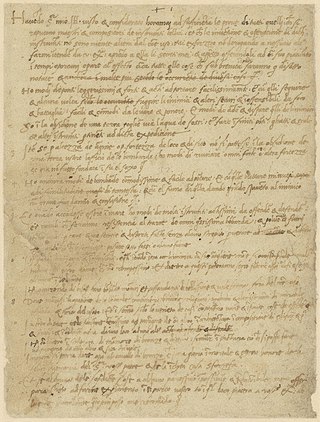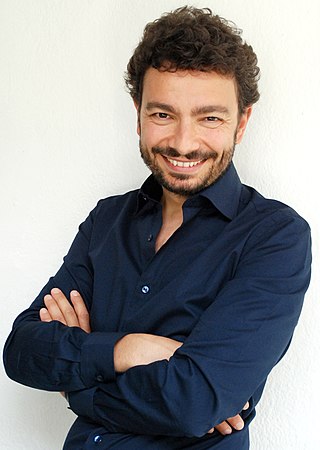
Leonardo di ser Piero da Vinci was an Italian polymath of the High Renaissance who was active as a painter, draughtsman, engineer, scientist, theorist, sculptor, and architect. While his fame initially rested on his achievements as a painter, he has also become known for his notebooks, in which he made drawings and notes on a variety of subjects, including anatomy, astronomy, botany, cartography, painting, and palaeontology. Leonardo is widely regarded to have been a genius who epitomised the Renaissance humanist ideal, and his collective works comprise a contribution to later generations of artists matched only by that of his younger contemporary Michelangelo.

The Codex Leicester is a collection of scientific writings by Leonardo da Vinci. The codex is named after Thomas Coke, Earl of Leicester, who purchased it in 1717. The codex provides an insight into the mind of the Renaissance artist, scientist and thinker, as well as an exceptional illustration of the link between art and science and the creativity of the scientific process.

Francesco Melzi, or Francesco de Melzi (1491–1567), was an Italian painter born into a family of the Milanese nobility in Lombardy. He became a pupil of Leonardo da Vinci and remained as his closest professional assistant throughout his career. After da Vinci's death he became the literary executor of all da Vinci's papers, editing them into a manuscript on painting he published as Trattato della Pittura [Treatise on Painting] or a compilation entitled the Codex Urbinas.

Walter Seff Isaacson is an American historian and journalist best known for having written biographies of important public figures, including Benjamin Franklin, Albert Einstein, Steve Jobs, and Elon Musk. As of 2024, Isaacson is a professor at Tulane University and, since 2018, an interviewer for the PBS and CNN news show Amanpour & Company.

Michael J. Gelb is an American non-fiction author, executive coach and management consultant. He is a senior fellow at the Center for Humanistic Management and member of the advisory board for Leading People and Organizations at the Fordham University Gabelli School of Business. He is also a Batten Institute Research Fellow at the University of Virginia Darden Graduate School of Business.

Leonardo da Vinci was an Italian Renaissance painter and polymath who achieved legendary fame and iconic status within his own lifetime. His renown primarily rests upon his brilliant achievements as a painter, the Mona Lisa and The Last Supper, being two of the most famous artworks ever created, but also upon his diverse skills as a scientist and inventor. He became so highly valued during his lifetime that the King of France bore him home like a trophy of war, supported him in his old age and, according to legend, cradled his head as he died.

Martin John Kemp is a British art historian and exhibition curator who is one of the world's leading authorities on the life and works of Leonardo da Vinci. The author of many books on Leonardo, Kemp has also written about visualisation in art and science, particularly anatomy, natural sciences and optics. Instrumental in the controversial authentication of Salvator Mundi to Leonardo, Kemp has been vocal on attributions to Leonardo, including support of La Bella Principessa and opposition to the Isleworth Mona Lisa.

The Italian polymath Leonardo da Vinci (1452–1519) left thousands of pages of writings and drawings, but rarely made any references to his personal life. The resulting uncertainty, combined with mythologized anecdotes from his lifetime, has resulted in much speculation and interest in Leonardo's personal life. Particularly, his personal relationships, philosophy, religion, vegetarianism, left-handedness and appearance.

Leonardo da Vinci (1452–1519) was an Italian polymath, regarded as the epitome of the "Renaissance Man", displaying skills in numerous diverse areas of study. While most famous for his paintings such as the Mona Lisa and the Last Supper, Leonardo is also renowned in the fields of civil engineering, chemistry, geology, geometry, hydrodynamics, mathematics, mechanical engineering, optics, physics, pyrotechnics, and zoology.

The 16th-century portrait Mona Lisa, or La Gioconda, painted in oil on a poplar panel by Leonardo da Vinci, has been the subject of a considerable deal of speculation.

Massimo Polidoro is an Italian psychologist, writer, journalist, television personality, and co-founder and executive director of the Italian Committee for the Investigation of Claims of the Pseudosciences (CICAP).

Mario Taddei is an Italian academic. He is an expert in multimedia and edutainment for museums, a Leonardo da Vinci devotee and scholar, and an expert in the codexes and machines of da Vinci and ancient books of technology.

Leonardo's Horse is a project for a bronze sculpture that was commissioned from Leonardo da Vinci in 1482 by the Duke of Milan Ludovico il Moro, but never completed. It was intended to be the largest equestrian statue in the world, a monument to the duke's father Francesco Sforza. Leonardo did extensive preparatory work for it but produced only a large clay model, which was later destroyed.
Charles Nicholl is an English author specializing in works of history, biography, literary detection, and travel. He has been active as a writer since the 1970s and has been publishing books since 1980. His subjects have included Christopher Marlowe, Arthur Rimbaud, Leonardo da Vinci, Thomas Nashe and William Shakespeare. He is a fellow of the Royal Society of Literature.

The portrait of a man in red chalk in the Royal Library of Turin is widely, though not universally, accepted as a self-portrait of Leonardo da Vinci. It is thought that Leonardo da Vinci drew this self-portrait at about the age of 60. The portrait has been extensively reproduced and has become an iconic representation of Leonardo as a polymath or "Renaissance Man". Despite this, some historians and scholars disagree as to the true identity of the sitter.

Gian Giacomo Caprotti da Oreno, better known as Salaì was an Italian artist and pupil of Leonardo da Vinci from 1490 to 1518. Salaì entered Leonardo's household at the age of ten. He created paintings under the name of Andrea Salaì. He was described as one of Leonardo's students and lifelong companion and servant and was the model for Leonardo's St. John the Baptist, Bacchus and Angelo incarnato.

Leonardo da Vinci is a 1996 children's biography by Diane Stanley. The book looks at Leonardo's life and accomplishments.

Tommaso di Giovanni Masini, known as Zoroastro da Peretola, was a friend and collaborator of Leonardo da Vinci.

Leonardo and the Last Supper, is a 2011 book written by Ross King, a Canadian novelist and non-fiction writer. He was awarded Canada's 2012 Governor General's Award for English-language non-fiction for Leonardo and the Last Supper, his examination of da Vinci's iconic 15th century religious mural.

Leonardo da Vinci: The Mind of the Renaissance is a 1996 illustrated biography of Leonardo da Vinci authored by the Italian art critic Alessandro Vezzosi, translated from Italian into French by Françoise Liffran, and published by Éditions Gallimard in the same year as the 293rd volume in their "Découvertes" collection. The book was adapted into a documentary film in 2001, by the title Léonard de Vinci.



















